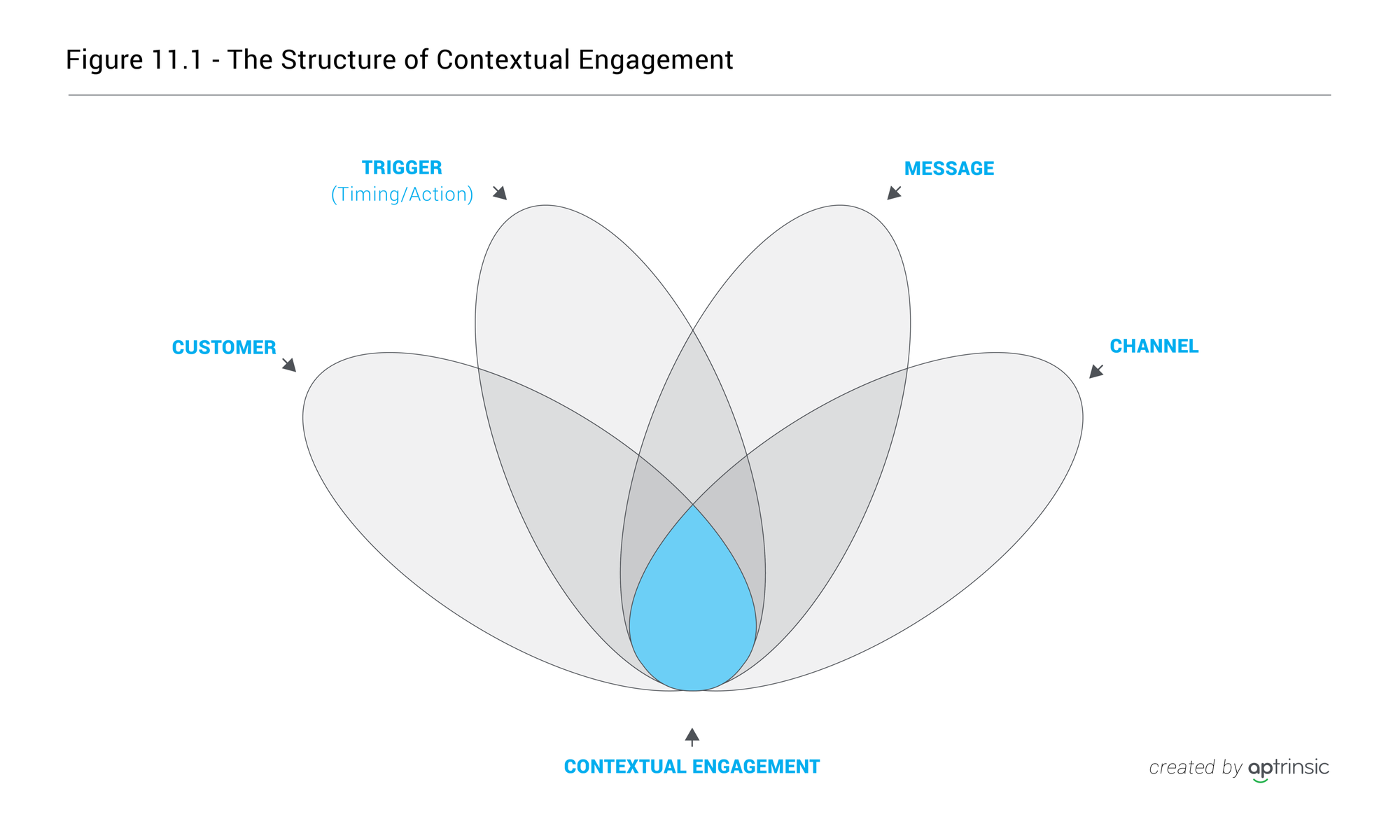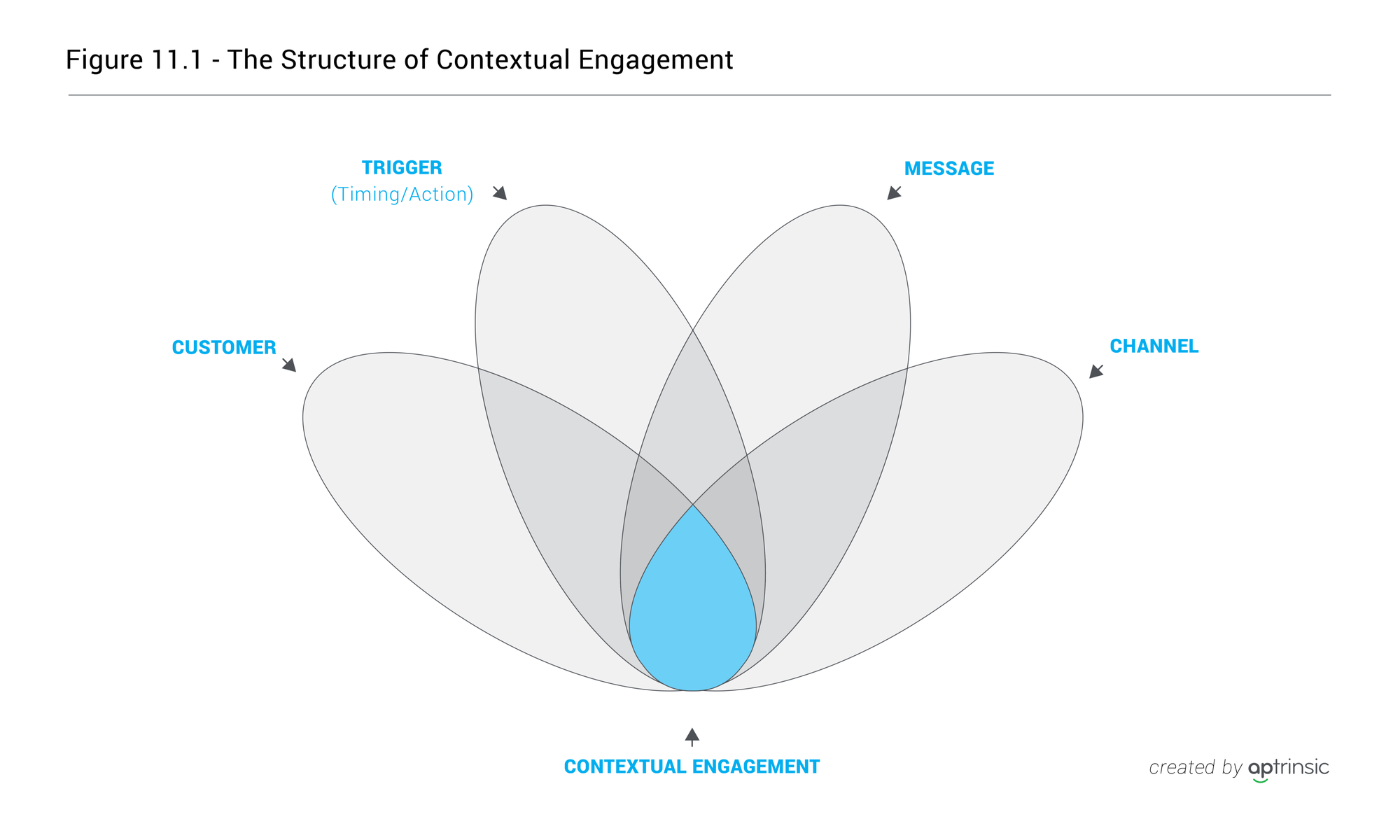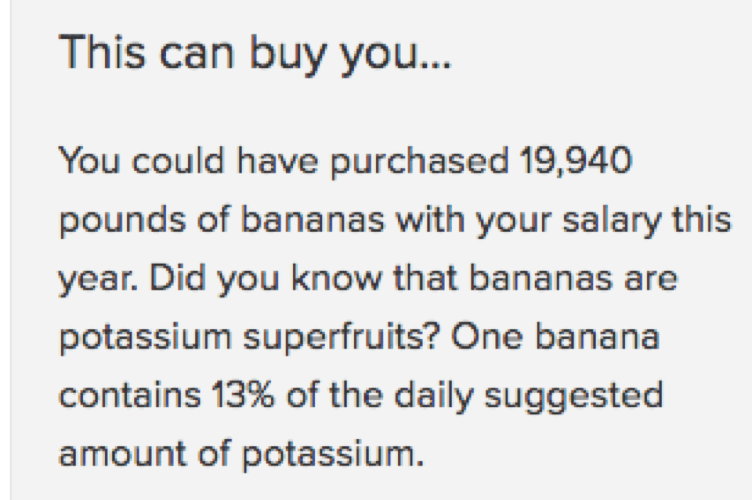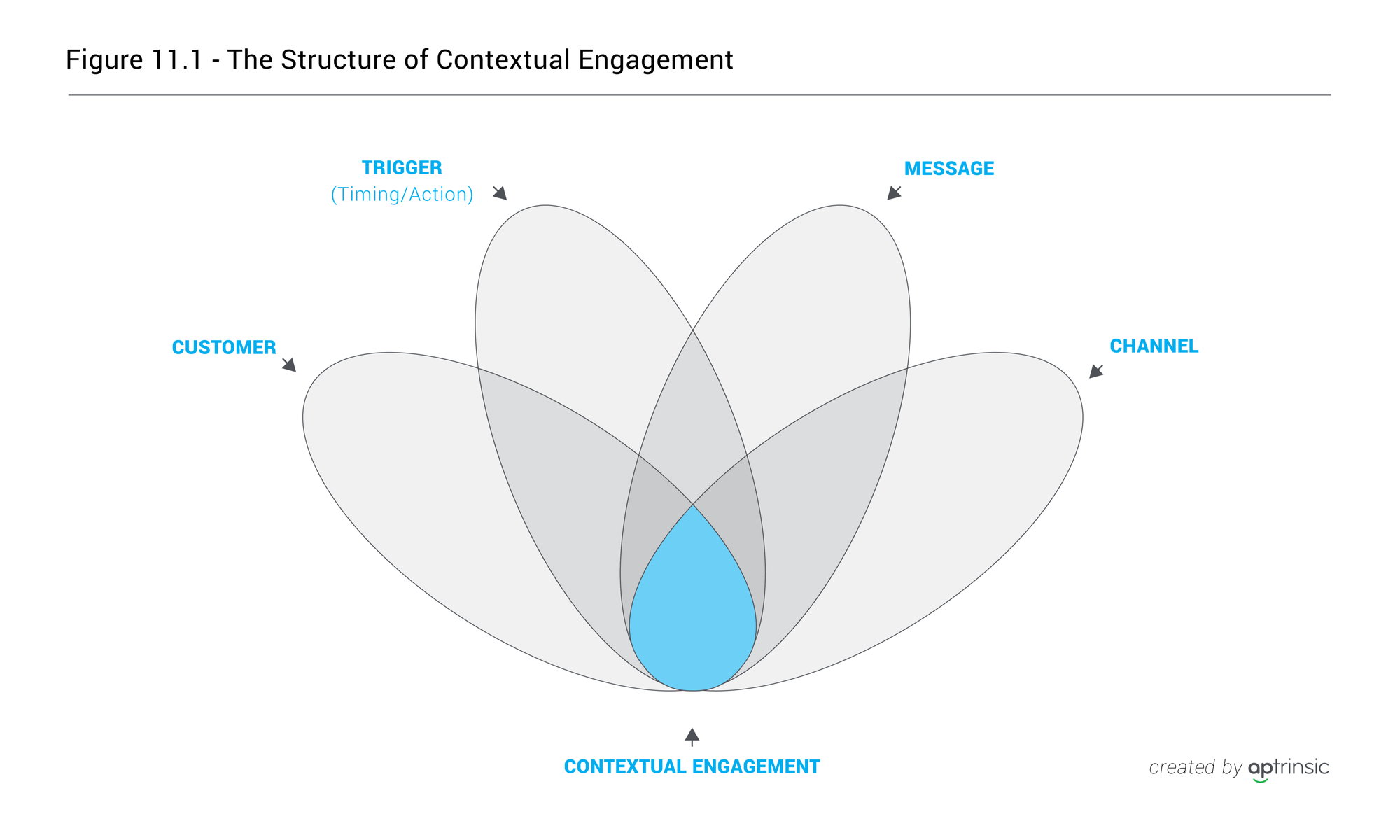Chapter 11: The Anatomy of Personalized Customer Engagement


A product-led GTM strategy is all about optimizing the customer acquisition process through personalized customer experiences and engagements. Designing those personalized customer experiences the right way is key to scaling and making the customer acquisition process more repeatable.
You can achieve this goal by combining customer segmentation, customer journeys, and nurturing.
11.1 Customer Segmentation
The two primary aspects of customer segmentation are demographics and behavioral data.
Segmentation = Demographics + Behavioral Data
This is not a new idea. However, when we talk about a product-led approach to customer acquisition, we emphasize the importance of in-product behavior. This is in contrast to behavior that happens in cross-channel marketing environments, including interactions with ads, e-mail opens, website visits, and so forth.
In-product customer behavior unlocks insights into the needs and values of your prospects and customers. (For a step-by-step process on segmenting customers, see this detailed article — “Customer Segmentation: A Guide to the Best B2B Practices”). A product-led strategy enhances the effectiveness of traditional segmentation. In addition, it enables you to better track and measure the performance of a particular segment throughout the customer lifecycle, including revenue impact and CLV vs. CAC ratio.
11.2 Customer Journey and Velocity
It’s critical for companies to map in-product customer journeys, because they can uncover important customer segments and needs based on the sequence of events and actions taken by customers on their way to achieving a goal.
For example, say your company provides a solution to streamline expense reports. Your teams originally designed a “first expense report” customer journey that required users to navigate four pages and five clicks. However, a large portion of your users reach this desired outcome in eight clicks. Seeing this, you could segment these users, and closely guide them through this process with a tutorial or walkthroughs. This use case illustrates an effective way to collaborate and experiment within the product before designing completely new product experiences.
Behavioral data also includes production data and customer journeys. Knowing that prospects interacted with a product feature is helpful. Connecting these insights with customer subscription data enables your teams to be more intelligent.
Most product analytics solutions tell you how a certain user or segment interacts with a product or feature. However, you must also know their subscription level, or how much revenue comes from the segment of customers that experience difficulties using the product — for example, if they need to take extra (i.e., too many) steps to execute a core action, such as sending an expense report. Without connecting these different data points, it is hard to estimate potential churn and revenue impact.
Mapping customer journeys helps teams understand whether product flows and features make sense to customers. The speed at which prospects move through the core journey enables your company to make some assumptions about the level of pain they are experiencing, as well as their buying intent.
Tip: Map customer journeys that lead to important desired outcomes; understand how quickly customers travel through these journeys and any associated risk of losing customers before they reach their goals.
11.3 In-Product Behavior and Habit Creation
In-product behavior is essential to personalized customer experiences, as it is the first step for influencing prospect and customer habit. Dr. BJ Fogg, the creator of “The Fogg Behavioral Model”, outlined three elements that must occur for behaviors to change: motivation, ability, and trigger. Your users need all three before your product will become an essential part of their daily lives.
Although you normally want more product usage, there are some cases when the less customers use the product, the more value they receive. For example, a product that sends an automated notification to customers when something is broken can be seen as valuable when the customers receive fewer of these notifications. However, for most software products, the more customers are engaged inside a product, the more value they experience.
With a product-led strategy, we filter out less-motivated prospects by asking them to sign up for a product. Assuming motivation is there, do prospects have the ability to execute actions leading to initial value? And when they realize initial value (which is the desired outcome), what triggers can be used to encourage a prospect or customer to repeat this action so they experience follow-on value?
Let’s take Salesforce as an example. Marc Benioff has done a tremendous job making the Salesforce brand the most synonymous with CRM. Every organization needs CRM — it’s where organizations aggregate customer relationship data. When a company starts reaching out to customers, the obvious question arises: Where do we keep track of all customer data and interactions? This is one of a few triggers that Salesforce uses effectively to create desire and a habit for their CRM solution.
To understand how triggers can help your company re-engage prospects and customers with your product, document a day in the life of your target customer. For example, at Aptrinsic, our goal is to connect with product leaders that make daily decisions about product features and messaging. We use this decision process as a trigger to encourage them to use our platform.
Ideally, a product team will turn to Aptrinsic when it is seeking ways to improve the onboarding experience, and product managers will log into Aptrinsic as they are planning which features to update. Within Aptrinsic, they can determine which features are used most often by customers, and how much revenue is associated with these features, to make the optimal decision. In other words, we want our customers to turn to Aptrinsic automatically whenever they are trying to improve their own products — just as so many of us automatically turn to Amazon when we want to buy a book online, or how so many businesspeople now turn to Slack if they need to collaborate with co-workers. Ultimately, every SaaS company should be focused on making their users turn to their products automatically and habitually. In other words, make users want to return to the product over and over again.
Tip: Describe a day in the life of your ideal customer to understand how your product fits in, and what triggers will cause the customer to re-engage with your product.
11.4 Moment of Joy
The gaming industry provides great examples of companies succeeding with product-led GTM strategies. The most successful gaming companies offer a free version of their game. They then engage, delight, and convert users through a variety of strategies, such as selling in-game goods, advancing paid users, or unlocking certain features. These are all triggers for realizing a Moment of Joy, which is the same as the Moment of Truth we spoke about earlier — the time when a prospect feels the value in the product.
Consider this: “Experienced gaming analysts know, for instance, that players who complete a number of actions during the same session have a significantly higher likelihood for a FTD [first-time deposit] as well as a higher retention rate.” In other words, that Moment of Truth is when companies are in the best position to convert a prospect into a paying customer.
One key to a successful, product-led conversion is to cultivate moments of joy with recognition and rewards when a user performs a desired action. We are not advocating that you use gamification as part of your SaaS product. However, it’s worth noting that game producers are driving success by being ultra-focused on getting players into the game early and incentivizing them in creative ways to pay. SaaS companies can learn how to better engage prospects in their products by understanding how gaming companies approach monetization.
SaaS companies should keep in mind that core actions and product features can bring valuable rewards to customers and prospects if delivered in the right context at the right time. Users can genuinely feel better about themselves, their work, and your product. Some companies celebrate such achievements with in-product congratulations messages, and by highlighting milestones as they are achieved.
In its analysis of how software companies scale quickly, OpenView Investments discovered three ways Slack is smart about the in-product experience:

- During the onboarding process, new users are taken through a tutorial when they first log in.
- The Help Center lays out next steps for new customers.
- Triggered in-app messaging encourages freemium users to convert to paid customers once they’ve reached their usage limit.
Even incorporating small things into your product can make the experience more personal for users. Let’s look at Gusto, a human resources management solution. Users can see and experience cool personalized messages that make it fun to use Gusto. For example, in the sidebar, Gusto calculates how many pounds of bananas you can buy with your salary — a nice way to entertain customers.
Slack does a great job incorporating messages that make it more joyful to use its product. The Slack signup process ends with this feel-good message:

Slack’s loading screen has a personality too:

Bottom line: When a prospect or customer reaches the desired outcome, use this opportunity to celebrate with them by creating small moments of joy. These intrinsic rewards will make your customers feel more empowered and improve their perception of your product’s value.
Tip: Identify core use cases and journeys where your team can create joyful moments to reinforce the value delivered with the product.
11.5 Nurturing and Contextual Engagements
In a traditional GTM strategy, the customer acquisition process relies heavily on nurturing leads via activities outside of the product, and is not typically supported by behavioral data within the product. With a product-led GTM strategy, your nurturing is driven by real-time contextual insights.
Nurturing (or drip e-mail) campaigns within a product-led GTM strategy are triggered by the customer’s in-product action or inaction. Contextual engagement happens when the right customer receives the right messages at the right time through the right channel.
Contextual Engagement = Customer + Trigger (Timing/Action) + Message + Channel

Let’s analyze what we mean by contextual engagement with the example depicted in Figure 11.1:
- Customer (WHO): Someone at his tenth day in a free trial process
- Trigger (WHEN): Hasn’t completed the journey to initial value
- Message (WHAT): Show the benefits of reaching initial value
- Channel (WHERE): In-product message + e-mail for a personalized experience
A customer reaches the tenth day of a free trial and hasn’t yet completed the journey to initial value. This triggers an in-product message and/or e-mail describing and illustrating the benefits of completing the journey. For inspiration, here’s an example of one of these e-mails from a company called RunKeeper offering a fitness app. The e-mail starts by pointing out that the recipient hasn’t used the app recently, and includes tips to get started.
11.6 The Importance of Omnichannel and Real-Time Personalization
You’re probably familiar with a multi-channel approach to customer acquisition, including social media, PR, website, and events; but a multi-channel approach doesn’t necessarily mean the customer experience, when it comes to messages and CTAs, is consistent from one channel to another. That’s because these channels are often managed in a siloed fashion. On the other hand, an omnichannel approach is designed to enable consistent experiences across all channels and devices.
An omnichannel approach helps companies create contextual engagement that looks and feels the same for customers across channels and devices. For example, an engagement with a specific customer segment can be simultaneously delivered via in-product messages, e-mails, and a mobile application; and with an omnichannel experience, you can easily know if a customer or prospect is on your website, logged into your product, or not engaging with you, so you can decide which channel to use.
The time that it takes for a company to create personalized engagement as a response to a prospect’s in-product behavior is a critical factor in the success of this engagement. If it takes a couple of days to pull relevant data and create an engagement response, the prospect might have already moved on. Acting in real time is critical in these situations.
Companies that find a way to create automated personalized engagement based on customer segments and behavior will more quickly get feedback and gather valuable analytics.
11.7 Experimentation and Optimization
The idea of experimentation isn’t new for marketers. However, with a product-led GTM strategy, companies can design experiments that test not only ads and landing pages, but also the whole experience, including onboarding and free trial requirements. For example, Salesforce can create a personalized onboarding process for an small-and-medium business (SMB) company versus a large enterprise.
Stephen Pavlovich, CEO of Conversion.com, explains how experimentation enables companies to gather valuable data that they can’t get anywhere else. He also outlines how it can help drive product growth.
11.8 Key Takeaways
There are eight ways to personalize customer engagement:
- Segmentation: Based on demographic and behavioral data, including interaction with ads, e-mail opens, and website visits.
- Customer Journey and Velocity: Understand how quickly customers travel through product journeys, and personalize these journeys to help them reach their goals.
- In-product Behavior and Habits: Understand the how three essential elements — motivation, ability, and trigger — apply to your customer’s day.
- Moment of Joy: Create joyful moments and use personalized messages to make customers feel empowered.
- Nurturing and Contextual Engagements: Based on in-product action, know the who, when, what, and where to help customers complete their journeys.
- Omnichannel and Real-time: Create and quickly deliver contextual engagements that look consistent across channels.
- Personalize Everything: Every aspect of a GTM strategy and the marketing mix can be personalized.
